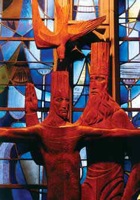Difference between revisions of "Triune"
| Line 15: | Line 15: | ||
==See Also== | ==See Also== | ||
| − | *[[Three]] | + | *'''''[[Three]]''''' |
| − | *[[Triad]] | + | *'''''[[Triad]]''''' |
| − | *[[Trinity]] | + | *'''''[[Trinity]]''''' |
| − | *[[104:5 Triodities|Triodities]] | + | *'''''[[104:5 Triodities|Triodities]]''''' |
| − | *[[104:4 The Seven Triunities| | + | *'''''[[104:4 The Seven Triunities|Trinunities]]''''' |
[[Category: General Reference]] | [[Category: General Reference]] | ||
Revision as of 13:51, 30 January 2013
Etymology
Latin tri- (three) + unus one — more at one
- Date: 1605
Description
In theology, and in philosophy related to it, trichotomy is the belief that man consists of three parts; a body, soul, and spirit. This stands in stark contrast to dichotomy.
Generally a trichotomy is a three-way classificatory division, and some philosophers pursued trichotomies in particular. Important trichotomies discussed by Aquinas include the causal principles (agent, patient, act) and the acts of the intellect (concept, judgment, reasoning), both rooted in Aristotle; the transcendentals of being (unity, truth, goodness); and the requisites of the beautiful (wholeness, harmony, radiance).
Charles Sanders Peirce built his philosophy on trichotomies and triadic relations based on his trichotomy of categories (firstness: quality of feeling; secondness: reaction, resistance, dyadic relation; and thirdness: representation, triadic relation).
